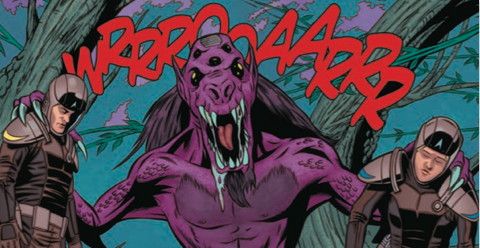
Next week IDW kicks off a new arc for their ongoing Star Trek comics and before we get to that review, TrekMovie is catching up on the most recent "Lost Apollo" series. Read the rocketing review below.
This has been a real rocketing kind of week. NASA’s Orbiting Carbon Observatory 2 was launched into orbit. NASA also approved production of a new rocket, the Space Launch System. Portlanders are getting ready to launch a rocket full of beer. Skottie Young’s Rocket Raccoon #1 was launched by Marvel this week. Not to mention those two short-range North Korean rockets fired into the Sea of Japan. And sadly, turmoil, tragedy and rockets launched in the Gaza as well. Remember the days when launching rockets was simpler? Like that prototype nuclear-powered rocket that launched the top secret Apollo X mission from the dark side of the moon?
Star Trek #33: Lost Apollo, Part 1 of 2
written by Mike Johnson, story consultant Roberto Orci, pencils by Joe Corroney, inks by Joe Corroney, Victor Moya and Rob Doan, colors by John Rauch, letters by Neil Uyetake, edits by Sarah Gaydos
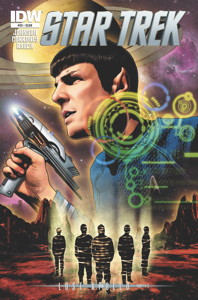
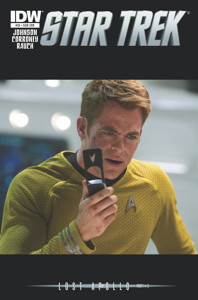
Cover: Art by Joe Corroney, Subscription Cover: Photo
Star Trek #34: Lost Apollo, Part 2 of 2
written by Mike Johnson, story consultant Roberto Orci, pencils by Joe Corroney, inks by Joe Corroney, Victor Moya and Rob Doan, colors by Sakti Yuwono of Stellar Labs, letters by Neil Uyetake, edits by Sarah Gaydos
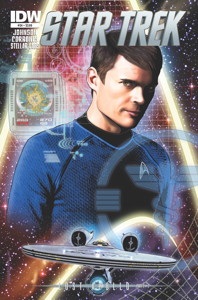
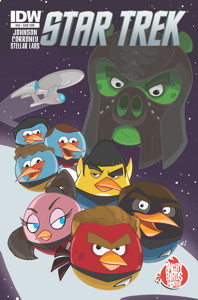
Cover: Art by Joe Corroney and colors by Brian Miller, Subscription Cover: Angry Birds art by Craig Rousseau
Story
Spring 1970 in Cocoa Beach, Florida. Captain Steve Cory goes home to tell his pregnant wife Tabitha the good news. He’s been selected for the Apollo program. Three hundred years later, the Enterprise is orbiting Hinrichs Five. A landing party led by Kirk beams down to survey the planet, finding an astonishing diversity of life, including what appear to be traces of human DNA and remnants of late twentieth century circuitry. They also find a small plastic bag with a child’s drawing preserved inside. As they are about to beam back to the ship, Sulu’s tricorder is snatched by a small animal. Giving chase, he’s separated from the landing party. Searching for Sulu, the landing party loses contact with the ship. Spock takes a security team to search for the missing crew. They all find each other, but not before they meet a belligerent native of the planet.
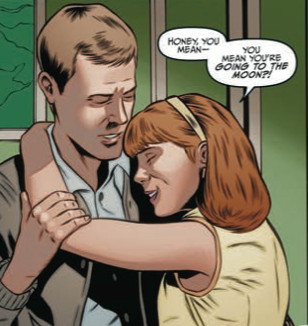
To the moon, Tabitha!
Summer 1972 in Cocoa Beach, Florida. Captain Steve Cory accepts a drawing from his daughter Ella and promises to tuck it into the pocket of his spacesuit for safekeeping. Three hundred years later, the landing party and security team are shaken but not seriously injured after an encounter with a native of Hinrichs Five.
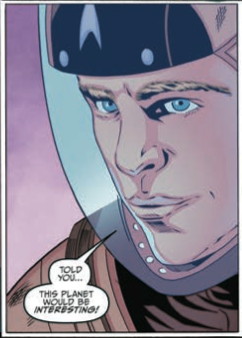
Told you so.
Back aboard the Enterprise they are astonished to learn that the alien is a 99.2% match to the human genome. They also learn that the genetic code of other flora and fauna found is constantly rewriting itself. Kirk is determined to solve the mystery. Beaming back to the planet’s surface, Kirk lures the alien into a trap with the child’s drawing. Back aboard the ship, the alien reverts to human form. The pilot of a secret Apollo mission launched from the dark side of the moon is in shock at what’s happened to him over the centuries.
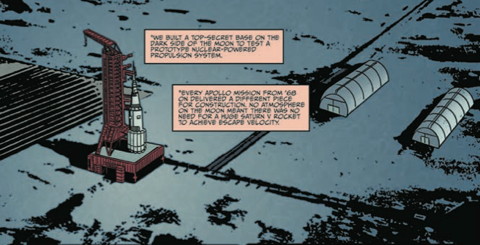
Come to the dark side!
Conscious only briefly, Captain Steve Cory succumbs to massive tumors spreading through his body. The lost pilot is taken back to the planet’s surface to save his life, returning to alien form. Only a child’s drawing speaks to his origin.
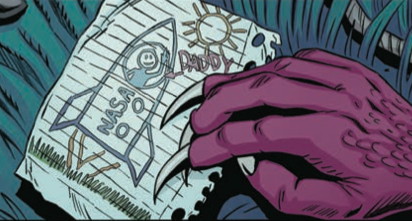
Life goes on.
Review
I’m ambivalent about Mike Johnson’s two-part Lost Apollo story arc. The framing story featuring a NASA astronaut on a secret mission feels very incomplete. The Enterprise mission log has some monster-of-the-week characteristics that bother me. We’re accompanied to the planet’s surface by some crew members that we don’t know very well and we don’t really get to know them any better. Finally, leaving Captain Cory alone on the planet is pretty lame, but I understand that the crew’s five-year mission must go on. I just hope the Enterprise will go on to stronger story lines. The strengths of this two-issue tale are all in art.
Joe Corroney’s visuals for this story arc are terrific, but I expect his work to be good. He gives us some stunning scenery on the planet’s surface in addition to a dynamic battle between the crew and a ferocious alien. It looks like he was having fun with this story. I don’t know if it’s just me, but I think Captain Steve Cory and his wife Tabitha resemble the actors Larry Hagman and Barbara Eden, who played a NASA astronaut and his 2,000-year-old genie in the late 1960’s sitcom, I Dream of Jeannie. The featured crew members are well-drawn and all involved in the art gave us their best efforts. Corroney has his own take on McCoy for the photorealistic cover of issue #34. The subscription cover for #34 is a tie-in with IDW’s Angry Birds Month, celebrating the launch of their ongoing Angry Birds comic series. Cover artist Craig Rousseau treats us to an Angry Original Series crew and a Klingon Pig. I can’t believe I got suckered into buying a copy, but it goes nicely with my Angry Klingon Bird-of-Prey t-shirt.
Star Trek #33 and #34 were released earlier this summer and are available in print and digital formats.
Coming Next – New Crew Meets Q + Ellison’s City on the Edge of Forever
Stay tuned for Star Trek #35, the first installment of the six-issue "Q Gambit" story arc, scheduled for release July 9. TrekMovie will have a review next week. And later this month look for our review of the second issue of Harlan Ellison’s City on the Edge of Forever, released July 23rd.
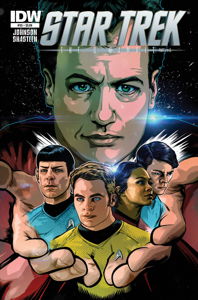
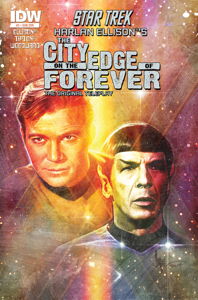
New Trek comics coming in July
AVAILABLE AT THING FROM ANOTHER WORLD
All the Star Trek comics can be pre-ordered at Thing From Another World. Click the banner below.
Mark Martinez is an obsessive-compulsive Star Trek comics reader and collector. You can visit his website, the Star Trek Comics Checklist for more than you ever needed to know about Star Trek comics.


@ Mark — It’s definitely a I Dream of Jeannie homage, in the show Larry Hagman’s character lives in Cocoa Beach. And of course by calling the wife Tabitha it evokes the other popular magic-based show of the era Bewitched. Tabitha is the name of Darren and Samantha’s daughter in the show.
I’d forgotten that Cocoa Beach was the locale for the TV show.
And the last name Cory… well, Hanna-Barbera made the animated Jeannie ’73 to ’75, that had Jeannie and genie-in-training Babu as servants of *Corry* Anders, a high-school student… voiced by Mark Hamill! So, there’s a weird pre-Wars connection to Luke Skywalker, eh?
*Corey* darn typo.
Star Trek: Dark of the Moon!
I just hate it that we had all this cool tech back in the 60’s and early 70’s — laser pens, mind-control pills, rockets that could reach another star system — and we lost it.
This story has a feel of something I would have read as an 8-year-old. Regrettably, I just don’t believe that 8-year-olds today are as unsophisticated as I was back then. *sigh* You can’t go home again.
I think the idea of launching a secret mission from the far side of the Moon is an interesting one, so maybe I’ll even buy this comic book, even though it’s been ages since I have.
Also, as a lot of people know, there isn’t really a “dark side” of the Moon, since the Moon as a whole is lit equally by the Sun. I don’t want to go all Phil Plait on everyone, of course. People refer to the “dark side” of the Moon only because, as a result of what is sometimes called tidal locking, it’s not visible to Earth (except for a tiny sliver on both sides due to orbital causes).
However, don’t tell that to Pink Floyd fans.
I thought #31 – #32 were an excellent origin story for 0718.
Can’t wait fit City on the Edge of Forever #2.
Nice to see comic reviews back! And Joe Corroney’s art is a big improvement over the last year’s art on Trek (the switched sex issues were quite weak!) Please keep the reviews coming!
To the reviewer: The second part of the story ends with Kirk mentioning that Starfleet would send a medical team to the planet to both monitor and search for a way to help Cory. It didn’t sound like he was being abandoned…
This two-parter is a complete waste of time. The art’s great, but the writing is all over the place.
This two-parter is all over the place, and is poorly written. It’s well-drawn, but the storyline has holes and continuity problems, and seems like it was rushed out the door without being properly finished.
Actually, I’ll go all Neil de Grasse Tyson on ya, Hat Rick…. there *is* a dark side of the Moon, it’s just that the dark side of the moon is constantly shifting and makes one full rotation every 29 days, 12 hours, 44 minutes and 3 seconds. So there!
.
If you built an equatorial rail system around the Moon’s 10921 km (6786 mi) circumference equator, you could move at a speed of about 15.41 km/h (9.57 mph), your railcar could stay on the Dark Side for longer periods of time. Some ideas for radio telescopes would do just that but instead of equatorially…. they’d circle about the Lunar South Pole.
.
But, yeah, the story of a lost Apollo X is silly. We already had TNG’s Season 2 The Royale and VOY’s Friendship One kinda cover this territory, didn’t we? And that was Colonel *STEVE* Richey.
.
I think Tracy Tormé could sue, the more I think about it.
@Daoud, The Sinfonian, 14,
In that case, I’ll raise your dark side of the Moon with a dark side of the Earth or essentially any other planet or other heavenly body orbiting the Sun. As far as the Earth is concerned, a little less than 50 per cent of the surface area of our home planet is always in the dark (not counting moonlight or starlight) at any given time, the difference being accounted for by atmospheric refraction. Technically, within that parameter, since the Earth is an oblate spheroid, the exact percentage of our planet that is in the dark may vary by a minute amount for that reason as well, depending on the orientation of the Earth as it orbits the Sun. I haven’t really thought about axial precession but it’s likely that its effects are for all intents and purposes washed out by other factors.
You may also have heard the dark side of the Earth being referred to as “night time,” lasting exactly one-half of one mean solar day.
Speaking of days, since we’ve gone one whole day without a new article here on TrekMovie.com, I thought I’d contribute a story idea. There’s a a story on BoingBoing about Star Trek Phase II that plays up the verisimilitude of sets between the fan production and TOS. However, the writer seems not to have heard of Star Trek Continues, which is also equally exacting in its attention to detail, and strikes me as even more similar to TOS when evaluated for lighting, camera angles, scene blocking, music, tempo, and the like.
See: http://boingboing.net/2014/07/04/startrekphaseii.html